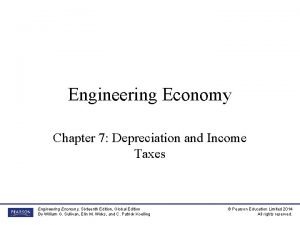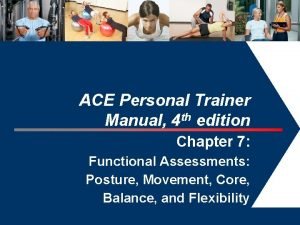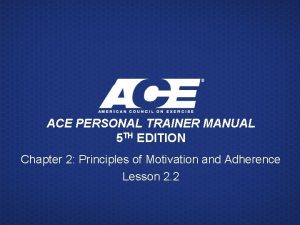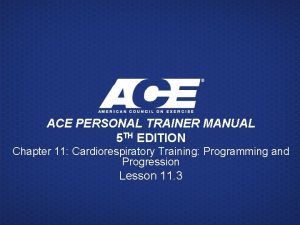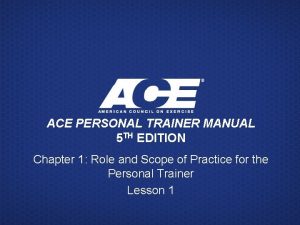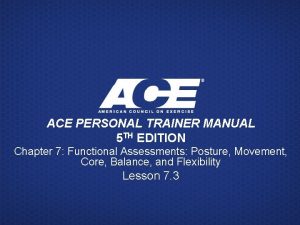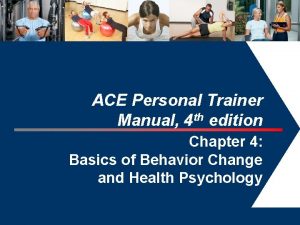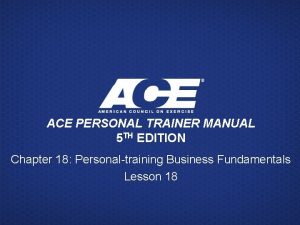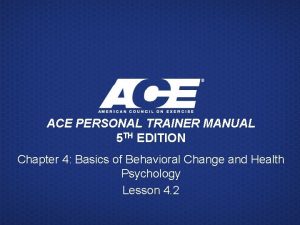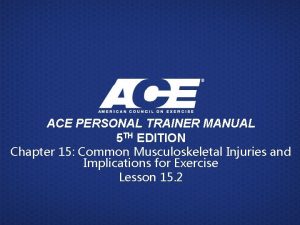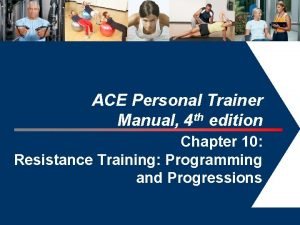ACE PERSONAL TRAINER MANUAL 5 TH EDITION Chapter





















- Slides: 21

ACE PERSONAL TRAINER MANUAL 5 TH EDITION Chapter 2: Principles of Motivation and Adherence Lesson 2. 1

LEARNING OBJECTIVES • After completing this session, you will be able to: ü Explain intrinsic and extrinsic motivation and selfefficacy ü Discuss the relationship between self-efficacy and motivation ü List and implement strategies to maintain client motivation ü Describe factors influencing exercise participation and adherence, including personal attributes, environmental factors, and physical-activity factors © 2014 ACE

UNDERSTANDING MOTIVATION • Numerous theoretical constructs have been proposed to explain motivation and its relationship with performance and achievement. • Sources of motivation include: ü The individual, much like a personality trait ü Other people’s encouragement, guidance, and support ü Things, ideas, and events © 2014 ACE

UNDERSTANDING MOTIVATION • Intrinsic motivation ü Intrinsic motivation is when a person is engaged in exercise activity for the inherent pleasure and experience that comes from the engagement itself. © 2014 ACE

UNDERSTANDING MOTIVATION • Extrinsic motivation ü Extrinsic motivation involves the engagement in exercise for any benefit other than for the joy of participation. © 2014 ACE

UNDERSTANDING MOTIVATION • Intrinsic and extrinsic continuum ü While many people truly enjoy being physically active, most adults depend on some amount of extrinsic motivation and fall somewhere on the continuum. © 2014 ACE

SELF-EFFICACY • © 2014 ACE Self-efficacy in an exercise context is defined as the belief in one’s own capabilities to successfully engage in a physical-activity program.

SELF-EFFICACY • Relationship between motivation and selfefficacy ü By being aware of selfefficacy levels, personal trainers will be better able to consistently motivate their clients and help them create positive self-belief. © 2014 ACE

SELF-EFFICACY AND MOTIVATION • By being aware of self-efficacy levels, personal trainers will be better able to consistently motivate their clients and help them create positive self-belief. • Additionally, personal trainers should: ü Use communication and awareness to be in touch with thought patterns of their clients ü Create short-term success by designing a workout that the client will master, which will demonstrate growth and achievement ü Be aware of how much feedback a client needs and then provide that support ü Help clients reevaluate appraisals of their physiological states to create more positive interpretations ü Teach clients to appropriately identify muscle fatigue, soreness, and tiredness, and help clients view the “feelings” of working out in a more positive light © 2014 ACE

BUILDING SELF-EFFICACY BY CHOOSING THE RIGHT ASSESSMENTS Most new clients will start a program with very low self-efficacy for exercise ability and program success. A big mistake many fitness professionals make is to schedule an entire session of assessments. As a personal trainer: • What are you doing to combat this issue from the very start of the program? • How do assessments make you feel? • When a person is out of shape and overweight, what is the likely result of the assessments? • What strategies can you take to make each new client leave the first session feeling good and looking forward to being part of the program? © 2014 ACE

MAINTAINING CLIENT MOTIVATION • © 2014 ACE It is important for any individual who participates regularly in a physical-activity program to implement strategies to prevent the occurrence of a relapse to an inactive state.

MAINTAINING CLIENT MOTIVATION: SOCIAL SUPPORT A social support network is an important coping strategy for relapse prevention. Individuals in a support network, such as family members and friends, must understand the commitment the client has made to being physically active. Personal trainers need to be creative in increasing their clients’ support systems: • Get family members and friends involved to some degree in the program • Offer joint participation by family or friends • Ask family and friends to demonstrate a positive attitude toward the client’s participation • Create a support system within the exercise environment: ü Maximize opportunities for group involvement and social interaction ü Ensure their clients feel as though they belong in the program ü Help clients feel like part of a team of people who have common interests and goals © 2014 ACE

MAINTAINING CLIENT MOTIVATION • Assertiveness ü Assertiveness is defined as the honest and straightforward expression of one’s thoughts, feelings, and beliefs. © 2014 ACE

MAINTAINING CLIENT MOTIVATION • Self-regulation ü Personal trainers should strive to teach their clients to become effective self-regulators of their own behaviors, schedules, time, and priorities. © 2014 ACE

MAINTAINING CLIENT MOTIVATION • High-risk situations ü Clients and trainers who identify high-risk situations will be more prepared to deal with program barriers and relapses. © 2014 ACE

STRATEGIES TO MAINTAIN CLIENT MOTIVATION What strategies will you use in your practice to help clients connect with others and fulfill their social outcome expectations? © 2014 ACE

FACTORS INFLUENCING EXERCISE PARTICIPATION • Research shows the following factors influence a person's decision to engage in exercise behavior: ü Personal attributes ü Environmental factors ü Physical-activity factors © 2014 ACE

FACTORS INFLUENCING EXERCISE PARTICIPATION • Personal attribute factors: ü ü ü © 2014 ACE Demographic variables Health status Activity history Psychological traits Knowledge, attitude, and beliefs

FACTORS INFLUENCING EXERCISE PARTICIPATION • Environmental factors: ü Access to facilities ü Time ü Social support © 2014 ACE

FACTORS INFLUENCING EXERCISE PARTICIPATION • Physical-activity factors: ü Intensity ü Injury © 2014 ACE

SUMMARY • Personal trainers must learn to maximize the experiences of their current clients which increases the likelihood that they will adhere to a program once they have started. • People who enjoy the physical-activity experience are likely to continue working with a personal trainer and remain involved in an exercise program. • When people believe that they can effectively engage in exercise behavior, they do so with a positive attitude and more effort and persistence. • A variety of strategies can be utilized to promote adherence, including social support and self-regulation, to prevent the occurrence of a relapse to an inactive state. © 2014 ACE
 Personal trainer insurance ace
Personal trainer insurance ace Personal trainer swot analysis
Personal trainer swot analysis Engineering economy 16th edition solution manual chapter 5
Engineering economy 16th edition solution manual chapter 5 Engineering economy 16th edition solution manual chapter 5
Engineering economy 16th edition solution manual chapter 5 Engineering economy 16th edition solution manual chapter 3
Engineering economy 16th edition solution manual chapter 3 Thomas test ace
Thomas test ace Mis chapter 6
Mis chapter 6 Using mis (10th edition) 10th edition
Using mis (10th edition) 10th edition Manual of structural kinesiology 18th edition
Manual of structural kinesiology 18th edition Chapter 8 personal finance
Chapter 8 personal finance Anylogic personal learning edition
Anylogic personal learning edition How to be a good trainer
How to be a good trainer Train the trainer objectives
Train the trainer objectives Luke trainer clark the boy who cried wolf
Luke trainer clark the boy who cried wolf Sheltered trainers
Sheltered trainers Sheltered 2 trainer
Sheltered 2 trainer Sheltered trainers
Sheltered trainers Ospfv
Ospfv My csudh portal
My csudh portal Mct enrollment tool
Mct enrollment tool Mehdi sebbane
Mehdi sebbane Heartfulness preceptors
Heartfulness preceptors


